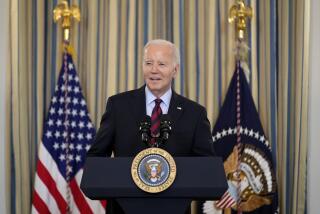Obama’s bottom line
There have been few, if any, dull moments in the first five weeks of Barack Obama’s presidency, at least when it comes to the economy. His first major proposal -- an economic stimulus package larger than any previous legislation of its kind -- caused a partisan brawl on Capitol Hill. His Treasury secretary triggered a sell-off on Wall Street when he announced a vague plan to ease the credit crunch by relieving banks of some illiquid assets. Other initiatives arrived weekly, including efforts to slow the pace of foreclosures, strengthen banks’ balance sheets and, most recently, provide a new regulatory structure for the financial industry. All the while, reports on joblessness, the housing market and other economic indicators have been almost universally gloomy, sometimes frighteningly so.
On Tuesday night, Obama offered some thematic unity tothe flurry of rescues and handouts. In a speech aimed more at the audience watching from home than the one inside the Capitol, he offered a solid rationale for the stimulus spending and tax cuts, the financial industry salvage projects and the aid to struggling borrowers. With resentment rising about the efforts to help borrowers and lenders who made bad bets on the housing market -- an anger personified by CNBC’s Rick Santelli -- the burden was on Obama to remind the public that the housing problems are connected to the credit crunch, which feeds into and is fed by the problems in the larger economy. He did that, although his remarks provided a better defense for bailing out Wall Street firms than troubledhomeowners.
But a good rationale, by itself, isn’t enough to instill the business and consumer confidence needed to cut short the recession. The administration and Congress also must act in a way that’s consistent with Obama’s powerful rhetoric. Already, the White House and House Democrats appear to be following different scripts; the same day Obama held a “fiscal responsibility summit” to explore ways to trim the deficit, the House Appropriations Committee unveiled a spending bill for the remaining seven months of the fiscal year that gave domestic programs 8% more, on average, than in the previous year. The implication is that lawmakers will use the recession as an excuse to treat every spending bill as a stimulus package, no matter what the White House says about sacrificing “worthy priorities for which there are no dollars.”
In addition, most of the president’s initiatives have been long on theory, short on detail. That’s one reason the stock market plunged after Treasury Secretary Timothy F. Geithner announced plans for modifying the Troubled Asset Relief Program -- Geithner provided an outline, but investors were hungry for enough specifics to judge the plan’s potential effectiveness. We understand the administration’s desire to show that it’s working on all the interlocking pieces of the economic downturn, but there are only so many times officials can say “Stay tuned!” before they lose credibility. At least there should be plenty of details in the budget the administration releases today. We’ll see how well Obama’s team sticks to the mission he laid out Tuesday.
More to Read
A cure for the common opinion
Get thought-provoking perspectives with our weekly newsletter.
You may occasionally receive promotional content from the Los Angeles Times.






